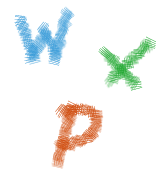Office icon colours: an unusual Microsoft legacy
 Here’s an interesting thought: When you think of word processors, spreadsheets, and overhead presentations, what colours come to mind? Blue, green and red respectively, right?
Here’s an interesting thought: When you think of word processors, spreadsheets, and overhead presentations, what colours come to mind? Blue, green and red respectively, right?
As far as I can tell, this branding exercise was a Microsoft invention, added in early versions of Microsoft Office to associate the components of Office (Word, Excel, Powerpoint) with the existing four-colour Windows logo (with yellow representing Outlook Express), but it’s persisted much further than that.
Google Docs, OpenOffice and LibreOffice all use the same colour scheme. Even Lotus Symphony has broken out of the Lotus standard colour scheme with its 2.0 icons.
I’m fascinated by subtle corporate branding that makes its way into the common consciousness without being obviously detected as such. What else is like this?


 Leeds-based non-binary nerd and sewist. I won't break my streak on Duolingo for anyone.
Leeds-based non-binary nerd and sewist. I won't break my streak on Duolingo for anyone.  Delicious
Delicious Leeds Beer Quest
Leeds Beer Quest Twitter
Twitter
Coca-Cola is red, Apple is silver…trying to think of others.
Coca-Cola have sort of associated the colour red with cola but I don’t think Apple have managed to make people think non-Apple products should always be silver…
on a somewhat-related note, isn’t it interesting how green has become an honorary primary color? if you’ve got something with four colors only, they’re usually red, yellow, blue and green. orange sneaks in there occaisonally, and purple is almost always left out of the mix, as if it’s too exotic.
For those of us who work with electronic UIs all the time, green is a primary colour and yellow is not. Red, green and blue are the colours closest to the pigments of the three types of rods & cones in the human eye so they’re more worthy of the title “primary colour” in my eyes (no pun intended).
Isn’t this just good, old-fashioned mimicry, as practised by those-things-that-look-like-wasps-but-aren’t and by any “own brand” product you’ll see in the supermarket?
The cereal aisle is the most striking. Clones of Fruit & Fibre are always purple; low/no sugar muesli blue, like Alpen; wholewheat brown, like Alpen; I think corn flakes are red, like Kelloggs. Wheat biscuits are yellow, like Weetabix. You don’t look for the name first; you look for the familiar colour and packaging shape first.
Off the cereal aisle, reduced crap baked beans are blue, like Heinz ones. Hot chocolate is almost always purple, like Cadburys. Yeast extracts must have a yellow lid on a bulbous brown glass jar, like Marmite. Crisp flavours are largely coloured consistently with Walkers.
I think there has to be one clear brand leader to set the colour. Where there’s competition, such as in supermarket “lager”, the own-brand gets confused by the choice of brands to emulate and can’t pick one to snuggle up to, so hides down low, away from eye level.